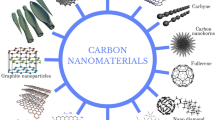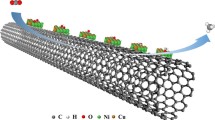Abstract
Multiwall carbon nanotubes (MWCNTs, 1–3 μM in length and 20–25 nm in diameter) were initially functionalized with a 2,2′:6′2″-terpyridine-chelated ruthenium(II) complex by covalent amidation. The resulting functionalized ruthenium MWCNTs (RuMWCNTs, 1–2 μM in length and 10–20 nm in diameter) were characterized by thermogravimetric analysis, X-ray photoelectronic spectroscopy (XPS), Fourier transform infrared spectroscopy (FTIR), Raman spectroscopy, and scanning electron microscopy (SEM). Thermogravimetric experiments of RuMWCNTs show that the functional group coverage of terpyridine–rutheniun–terpyridine (tpy–Ru–tpy) is 0.7036 mmol/1.0 g carbon. The XPS results show N1s and Ru3d5/5 signals, confirming the presence of tpy–Ru–tpy groups on the surface of MWCNTs. The FTIR spectra of the RuMWCNTs display the typical stretching mode of the carboxyl group (amide I) and a combination of amide N–H and C–N stretching mode (amide II). The Raman D- and G-line peak intensity ratio of RuMWCNTs (ID/IG 2.21) exceeds that of pristine MWCNTs (ID/IG 1.93), suggesting covalent bonding of tpy–Ru–tpy to MWCNTs and supporting the disruption of the graphitic integrity due to the proposed covalent functionalization. High-resolution SEM images confirm that tpy–Ru–tpy moieties are interconnected or attached as aggregated structures (100–200-nm range) on the surfaces of the carbon nanotubes after functionalization. The electrical property of RuMWCNTs depicts higher resistance (10.10 M Ω) than that of OX-MWCNTs (15.38 kΩ).












Similar content being viewed by others
References
Avouris P, Dresselhaus G, Dresselhaus MS (2000) Carbon nanotubes: synthesis, structure, properties and applications. Springer, Berlin
Bahr JL, Tour JM (2002) Covalent chemistry of single-wall carbon nanotubes. J Mater Chem 12:1952–1958
Baskaran D, Mays JW, Bracher MS (2004) Polymer-grafted multiwalled carbon nanotubes through surface-initiated polymerization. Angew Chem Int Ed 43:2138–2142
Chen RJ, Zhang Y, Wang D, Dai HJ (2001) Noncovalent sidewall functionalization of single-walled carbon nanotubes for protein immobilization. J Am Chem Soc 123:3838–3839
Chen J, Liu HY, Weimer WA, Halls MD, Waldeck DH, Walker GC (2002) Noncovalent engineering of carbon nanotube surfaces by rigid functional conjugated polymers. J Am Chem Soc 124:9034–9035
Datsyuk V, Kalyva M, Papagelis K, Parthenios J, Tasis D, Siokou A, Kallitsis I, Galiotis A (2008) Chemical oxidation of multiwalled carbon nanotubes. Carbon 46:833–840
Dohn S, Mφihave K, Peter B (2005) Direct measurement of resistance of multiwalled carbon nanotubes using micro four-point probes. Sensor Lett 3:1–4
Eranda M, Atula SDS, Taku H, Osamu I, Francis DS (2010) Sensitive efficiency of photoinduced electron transfer to band gaps of semiconductive single-walled carbon nanotubes with supramolecularly attached zinc porphyrin bearing pyrene glues. J Am Chem Soc 132:8158–8164
Fallahpour R, Neuburger M, Zehnder M (1999) Homoleptic and heteroleptic iron (II) and ruthenium (II) complexes of novel 4′-nitro-2,2′:6′,2″-terpyridines and 4′-amino-2,2′:6′,2″-terpyridines. New J Chem 23:53–61
Frehill F, Vos JG, Benrezzak S, Koós AA, Kónya Z, Rüther MG, Blau WJ, Fonseca A, Nagy JB, Biro LP, Minett AI, Panhuis M (2002) Interconnecting carbon nanotubes with an inorganic metal complex. J Am Chem Soc 124(46):13694–13695
Gao C, Jin Y, Kong H, Whitby RLD, Acquah SFA, Chen GY, Qian H, Hartschuh A, Silva SRP, Henley S, Fearon P, Kroto HW, Walton DRM (2005) Polyurea-functionalized multiwalled carbon nanotubes: synthesis, morphology, and Raman spectroscopy. J Phys Chem B 109:11925–11932
Harris PJF (1999) Carbon nanotubes and related structures. Cambridge University Press, Cambridge
Hill DE, Lin Y, Allard LF, Sun Y (2002) Solubilization of carbon nanotubes via polymer attachment. Intl J Nanosci 1:213–221
Hirsch A, Vostrowsky O (2005) Functionalization of carbon nanotubes. Top Curr Chem 245:193–237
Hofmeier H, Schubert US (2004) Recent developments in the supramolecular chemistry of terpyridine–metal complexes. Chem Soc Rev 33:373–399
Hou P, Liu C, Tong Y, Xu S, Liu M, Cheng H (2001) Purification of single-walled carbon nanotubes synthesized by the hydrogen arc-discharge method. J Mater Res 16:2526–2529
Huang H, Liu I, Chang C, Tsai H, Hsu C, Tsiang R (2004) Preparing a polystyrene-functionalized multiple-walled carbon nanotubes via covalently linking acyl chloride functionalities with living polystyryllithium. J Polym Sci A 42:5802–5810
Hwang S, Moorefield CN, Dai L, Newkome GR (2006) Functional nanohybrids constructed via complexation of multiwalled carbon nanotubes with novel hexameric metallomacrocyles. Chem Mater 18:4019–4024
Iijima S (1991) Helical microtubules of graphitic carbon. Nature 354:56–58
Karousis N, Tagmatarchis N, Tasis D (2010) Current progress on the chemical modification of carbon nanotubes. Chem Rev 110:5366–5397
Kelch S, Rehahn M (1999) Synthesis and properties in solution of rodlike, 2,2′:6′2″-terpyridine-based ruthenium (II) coordination polymers. Macromolecules 32:5818–5828
Khairoutdinov RF, Doubova LV, Haddon RC, Saraf L (2004) Persistent photoconductivity in chemically modified single-wall carbon nanotubes. J Phys Chem B 108:19976–19981
Li Y, Qi H, Fang F, Zhang C (2007) Ultrasensitive electrogenerated chemiluminescence detection of DNA hybridization using carbon-nanotubes loaded with tris(2,2′-bipyridyl) ruthenium derivative tags. Talanta 72:1704–1709
Li J, Guo L, Gao W, Xia X, Zheng L (2009) Enhanced electrochemiluminescence efficiency of Ru(II) derivative covalently linked carbon nanotubes hybrid. Chem Commun 12:7545–7547
Lin Y, Rao AM, Sadanadan B, Kenik EA, Sun Y (2002) Functionalizing multiple-walled carbon nanotubes with aminopolymers. J Phys Chem B106:1294–1298
Mcqueen EW, Goldsmith JI (2009) Electrochemical analysis of single-walled carbon nanotubes functionalized with pyrene–pendant transition metal complexes. J Am Chem Soc 131:17554–17556
Muller M, Papagelis K, Maultzsch J, Stefopoulos AA, Pefanakis EK, Andreopoulou AK, Kallitsi JK, Thomsen C (2009) Raman spectroscopy of single wall carbon nanotubes functionalized with terpyridine–ruthenium complexes. Phys Status Solidi B 246:2721–2723
Ou YY, Huang MH (2006) High-density assembly of gold nanoparticles on multiwalled carbon nanotubes using-pyrenemethylamine as interlinker. J Phys Chem B 110:2031–2036
Pan Y, Tong B, Shi J, Zhao W, Shen J, Zhi J, Dong Y (2010) Fabrication, characterization, and optoelectronic properties of layer-by-layer films based on terpyridine-modified MWCNTs and ruthenium (III) ions. J Phys Chem C 114:8040–8047
Petrov P, Stassin F, Pagnoulle C, Je’rome R (2003) Noncovalent functionalization of multi-walled carbon nanotubes by pyrene containing polymers. Chem Commun 7:2904–2905
Reich S, Thomson C, Maultzsch J (2004) Carbon nanotubes: basic concepts and physical properties. Wiley, New York
Schubert US, Escherichia C (2002) Macromolecules containing bipyridine and terpyridine metal Complexes: towards macromolecular polymers. Angew Chem Int Ed 41:2892–2926
Schubert US, Hofmeier H, Newkome GR (2006) Modern terpyridine chemistry. Wiley-VCH, Weisenheimer
Schuman SB, Voltaic B, Biswas S, Thirster B, Schoolmaster LJ (2002) Electrical behavior of isolated multiwall carbon nanotubes characterized by scanning surface potential microscopy. Appl Phys Lett 81:541–543
Singh RP (2011) Prospects of materializations for biosensing. Int J Electrochem 2011:1–30
Star A, Liu Y, Grant K, van Rid L, Stoddard JF, Steuerman DW, Diesel MR, Bourbaki A, Heath JR (2003) Noncovalent side-wall functionalization of single-walled carbon nanotubes. Macromolecules 36:553–560
Stefopoulos AA, Pakistanis EK, Papagelis K, Andreopoulou AK, Kallitsis JK (2009) Carbon nanotubes decorated with pyridine–ruthenium complexes. J Polym Sci A 47:2551–2559
Steuerman DW, Star A, Notarization R, Chou H, Rees RS, Nicoline C, Stoddard JF, Heath JR (2002) Interactions between conjugated polymers and single-walled carbon nanotubes. J Phys Chem B 106:3124–3130
Sun YP, Fu K, Lin Y, Huang W (2002) Functionalism carbon nanotubes: properties and applications. Acc Chem Res 35:1096–1104
Tanaka K, Yamaha T, Fukuoka K (1999) The science and technology of carbon nanotubes. Elsevier, Oxford
Tang M, Doy H, Sun K (2006) One-step synthesis of dextrose-based stable nanoparticles assisted by self-assembly. Polymer 47:728–734
Tang B, Yu F, Li P, Tong L, Dyan X, Xe T, Wang X (2009) A near-infrared neutral pH fluorescent probe for monitoring minor pH changes: imaging in living HepG2 and HL-7702 cells. J Am Chem Soc 131:3016–3023
Tasis D, Tagmatarchis N, Bianco A, Pratt M (2006) Chemistry of carbon nanotubes. Chem Rev 106:1105–1135
Tasis D, Papagelis K, Pratt M, Kallitsis I, Galiotis C (2007) Water-soluble carbon nanotubes by redox radical polymerization. Macromol Rapid Commun 28:1553–1558
Wang X, Liu Y, Shu D (2001) Pillar-shaped structures and patterns of three-dimensional carbon nanotube alignments. Chem Commun 8:751–752
Wang P, Moorefield CN, Li S, Marquez J, Shredding CD, Busts E, Shredding CD, Busts E, Hartley AL, Godliness LA, Newkome GR (2007) Synthesis of a water-soluble hexameric metallography and its oxidized single-wall carbon nanotube composite. J Mater Chem 17:3023–3029
Yang LP, Pan CY (2008) A non-covalent method to functionalize multi-walled carbon nanotubes using six-armed star poly(L-lactic acid) with a triphenylarsine core. Macromol Chem Phys 209:783–793
Yang W, Rating KR, Ringer SP, Thorstein P, Golding JJ, Bret F (2010) Carbon nanomaterials in biosensors: Should you use nanotubes or graphene? Angew Chem Int Ed 49:2114–2138
Zdrojek M, Gerick W, Jastrow C, Melina T, Huck A (2004) Studies of multiwall carbon nanotubes using Raman spectroscopy and atomic force microscopy. Solid State Phenom 99(100):265–268
Acknowledgments
The authors thank the National Science Foundation (NSF CREST program, Grant Award # HRD-11137751) for financial support for this research. We also thank Dr. Eric Mintz in Department of Chemistry at CAU for the use of Raman and TGA instruments (NASA under Cooperation Agreement NCC3-1044).
Author information
Authors and Affiliations
Corresponding author
Electronic supplementary material
Appendix A. Supplementary data: The synthesis procedure, FTIR, NMR and MS spectra of terpyridine ligand and ruthenium terpyridine complexes in experimental section are available in the attached supporting information.
Rights and permissions
About this article
Cite this article
Li, H., Wu, J., Jeilani, Y.A. et al. Modification of multiwall carbon nanotubes with ruthenium(II) terpyridine complex. J Nanopart Res 14, 847 (2012). https://doi.org/10.1007/s11051-012-0847-z
Received:
Accepted:
Published:
DOI: https://doi.org/10.1007/s11051-012-0847-z




